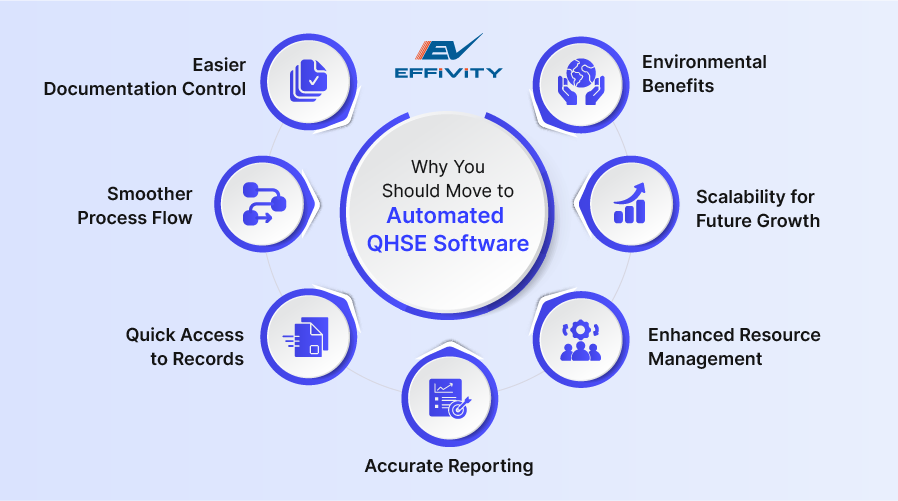For an organization operating in a strict regulatory environment, maintaining high levels of quality, occupational health and safety, and environmental measures is a must. However, manual processes can only do so much to achieve the level of efficiency and compliance that businesses require.
It's not only time-consuming and costly but can often lead to duplication of efforts, especially since you have to manage quality, health, safety and environmental processes together.
Despite that, many companies still use the decades-old paper-based manual system, resulting in a complicated, rigid and unproductive management system. In fact, this defeats the very purpose of implementing an ISO management system – to be leaner, improve processes, achieve customer satisfaction & manage risks effectively.
As a result, switching to an automated software solution is necessary to reduce the complexity of managing multiple management systems together, simplify maintenance and maintain your documentation for various requirements of ISO 9001:2015, ISO 14001:2015, OHSAS 18001:2007 or ISO 22000 FSMS.
Here are some reasons to consider using ISO QHSE software to maintain quality, health, safety and environmental management systems.

1. Easier Documentation Control
One of the most significant challenges of manually managed ISO systems is handling documentation. Maintaining physical records of procedures, policies and audits can quickly become overwhelming, especially for companies with multiple locations. Not to forget, if you're managing process documentation manually in a book or shared drive, it can be difficult to ensure that employees get easy access to updated information at all times.
Moving from manual to digital documentation with QHSE management systems simplifies document management by providing centralized digital storage. All relevant documents can be easily uploaded, stored and accessed with a few clicks. This reduces the risk of losing important documents and ensures compliance with ISO standards, as all files are systematically organized and up-to-date during audits.
Automated notifications also alert users about document updates, changes and approvals, keeping everything compliant with minimal manual effort.
2. Smoother Process Flow
Certain management system processes, such as corrective action and improvements, can be difficult to understand and work through, especially if they are not routinely involved in the organization's work.
Automated QHSE management software is pre-configured with the requirements and processes of quality, environmental and health and safety management systems, allowing your employees to work through these unfamiliar processes easily.
Further, automated QHSE software integrates multiple management system workflows seamlessly. Tasks are automatically assigned to the right people, with clear deadlines and guidelines. This results in smoother process flows, where issues like communication gaps or delays in decision-making are minimized.
3. Quick Access to Records
When using a manual system, accessing historical data or current records often involves sifting through multiple files and storage locations. Plus, there's the possibility of delays from the creation of records to storage and retrieval, which can also lead to loss of information.
Automated QHSE systems provide quick and easy access to all records with digital document management. Employees can retrieve data within seconds, whether it's past audits, safety incidents, or quality reports within a quality management software. This instant access saves time and ensures that decision-makers have all the necessary information at their fingertips, leading to timely actions.
4. Accurate Reporting
Generating and accessing reports manually is time-consuming and prone to human error. In contrast, automated ISO QHSE management software allows accurate, real-time reporting. The system automatically collects and organizes data, ensuring that reports are precise and up-to-date. You can track key performance indicators (KPIs) or generate audit reports.
The software reduces the risk of errors while providing comprehensive insights into the organization's QHSE performance. This increased accuracy enhances decision-making, as leaders can rely on data that reflects the true state of the business.
5. Enhanced Resource Management
An often-overlooked benefit of moving to automated QHSE software is the improvement in resource management. When maintaining a management system manually, your organization will require more personnel, physical storage and time to ensure that the systems are functioning and up-to-date. Besides, these factors also increase operational costs.
However, these resources are significantly reduced by an automated system. The tool automatically manages every aspect of the QHSE system in the organization, enhancing efficiency. Additionally, the software's ability to streamline operations and improve resource utilization leads to further cost reductions.
While investing in QHSE software may seem like a significant expense upfront, the long-term cost savings are substantial.
6. Scalability for Future Growth
As businesses grow, their QHSE requirements evolve. Manually managed systems often struggle to keep pace with this growth, requiring more paperwork, staff and time to maintain compliance. Automated QHSE software, on the other hand, is easily scalable.
New users, locations and processes can be integrated into the system without any significant disruptions. This scalability ensures that businesses remain compliant, efficient and productive, no matter how large or complex their operations become.
7. Environmental Benefits
By moving from a paper-based QHSE system to a paperless document management, organizations contribute to environmental sustainability. Eliminating the need for printed documents reduces paper consumption, printing costs and waste.
Many companies are increasingly prioritizing environmental responsibility and adopting a paperless environmental management system software that aligns with those goals. This transition benefits the environment and enhances the company's reputation as a forward-thinking, eco-conscious organization.
To Wrap Up
The transition from a manually managed ISO system to a paperless automated ISO QHSE management software is a strategic move that can drastically improve operational efficiency, compliance and productivity. From easier documentation control to enhanced resource management, the benefits of automation are undeniable. As businesses continue to face growing regulatory pressures and competitive challenges, adopting automated solutions is the key to staying ahead.






























